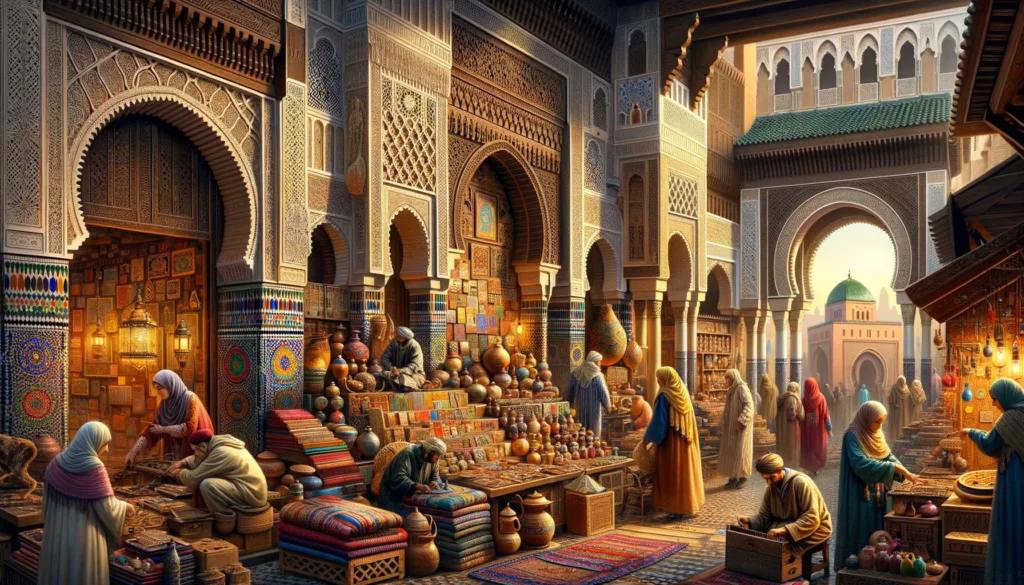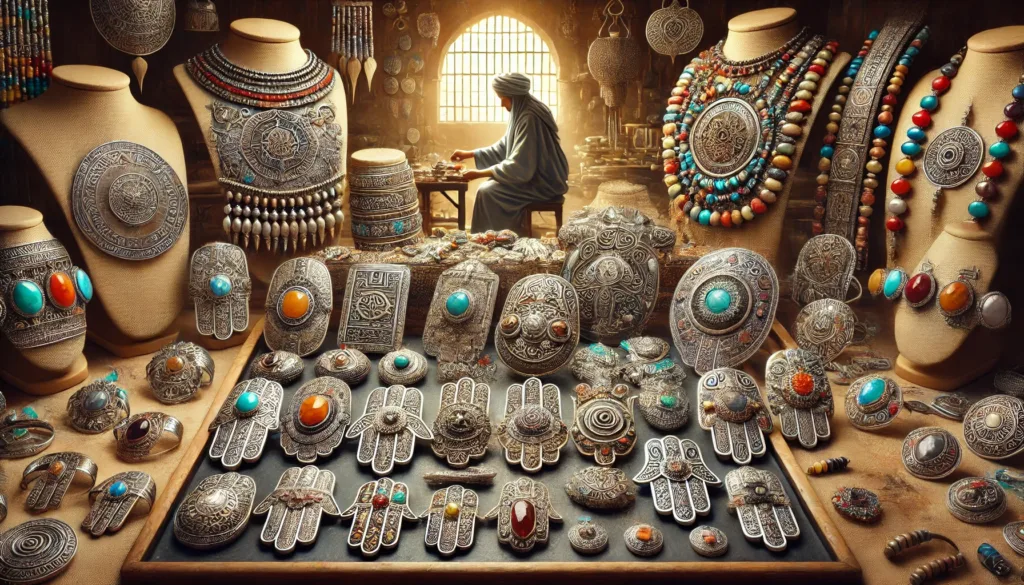
Morocco’s artistic heritage is a mesmerizing tapestry woven from centuries of history, diverse cultural influences, and unparalleled craftsmanship. From the intricate geometric patterns that adorn mosques to the vibrant textiles produced by generations of artisans, Moroccan art is a testament to the country’s rich and multifaceted identity.
Shaped by geography and a confluence of civilizations—including Arab, Berber, Andalusian, and Sub-Saharan African cultures—Moroccan art embodies a unique fusion of tradition and innovation. The country’s historic trade routes and strategic location at the crossroads of Africa, Europe, and the Middle East have further enriched its artistic expressions.
For international travelers, Moroccan art serves as a visual and tactile journey through the country’s history. Whether it’s the hypnotic patterns of zillij mosaics, the exquisite calligraphy carved into plaster, or the opulent embroidery adorning traditional garments, every piece tells a story. In this article, we explore the depth and beauty of Morocco’s traditional artistic forms, shedding light on their cultural significance and enduring appeal.
Visual and Decorative Art
Islamic Geometric Patterns
One of the most striking aspects of Moroccan visual art is its deep-rooted connection to Islamic geometry. Islamic teachings often discourage the depiction of human and animal figures in religious contexts, leading artisans to develop highly sophisticated geometric motifs. These intricate designs symbolize the infinite nature of creation and can be found in architectural elements, textiles, and ceramics.
Zillij Tiles
Zillij, the centuries-old art of mosaic tilework, is a hallmark of Moroccan design. Composed of hand-chiseled ceramic pieces arranged into elaborate patterns, zillij is a defining feature of palaces, mosques, and riads (traditional Moroccan houses). The craftsmanship behind these mosaics requires painstaking precision, with each piece carefully shaped and assembled to create mesmerizing designs that reflect both artistic mastery and cultural heritage.
Carved Plaster, Wood, and Calligraphy
Moroccan architecture is renowned for its intricate detailing, much of which is achieved through carved plaster and woodwork. Skilled artisans, known as maalems, meticulously sculpt arabesques, floral motifs, and Quranic inscriptions into surfaces, transforming walls and ceilings into breathtaking works of art.
Plasterwork
Stucco carvings, often seen in grand structures like the Alhambra in Spain and Moroccan madrasas, add a delicate yet striking aesthetic to interiors. These designs create an interplay of light and shadow, enhancing the visual impact of architectural spaces.
Woodwork and Mashrabiya
Wood carving is another integral aspect of Moroccan decorative arts. From elaborately painted cedar doors to intricate latticework known as mashrabiya, wooden elements contribute to the aesthetic harmony of Moroccan interiors.
Calligraphy
Arabic calligraphy, often intertwined with geometric and floral motifs, is highly revered in Moroccan art. Found on mosque walls, ceramic tiles, and manuscript illuminations, calligraphy is not just a means of communication but a refined artistic expression steeped in spiritual significance.
Moroccan visual and decorative art is a reflection of the country’s immense artistic legacy. With its dynamic patterns and meticulous craftsmanship, it continues to captivate visitors and locals alike, offering a window into Morocco’s enduring creative spirit.
Textile and Fashion Traditions
Carpet Weaving
Moroccan carpets are more than just decorative pieces—they are woven narratives of history, culture, and identity. Across Morocco, various regions produce distinct styles, with each carpet telling a unique story through its patterns, colors, and textures.
Regional Varieties
Rural Berber tribes, such as the Beni Ourain, are known for their thick, soft wool carpets featuring abstract, monochrome geometric designs. Meanwhile, the cities of Fez and Rabat produce urbanized, ornate rugs often featuring intricate floral or arabesque motifs influenced by Islamic artistry.
Traditional Techniques
Carpet weaving in Morocco is a labor-intensive, highly skilled craft passed down through generations. Artisans use sheep’s wool, camel hair, or silk fibers, carefully hand-knotting or flat-weaving each piece using looms and natural dyes derived from local plants and minerals.
Cultural Symbolism
Every motif woven into a Moroccan carpet carries cultural significance. Diamonds and zigzag lines often represent protection against evil spirits, while symmetrical designs symbolize balance and harmony in life.
Traditional Clothing
Morocco’s traditional attire reflects its deeply rooted cultural heritage, blending utility with elegance. Cultural influences from Berbers, Arabs, and Andalusians contribute to the diversity of Moroccan fashion.
Key Elements of Moroccan Dress
The djellaba, a long, flowing robe with a pointed hood, is a staple worn by both men and women. Women often wear the kaftan, an elaborately decorated garment often seen at celebrations, while men don a sophisticated belted version called the jabador.
Materials and Designs
Moroccan fabrics are rich in texture and color, with embroidery, gold thread detailing, and silk accents commonly featured. Fez is famed for its fine silks, while Marrakech and Essaouira specialize in woolen textiles perfect for cooler climates.
Jewelry and Ornamentation

Berber Jewelry
Jewelry in Morocco is not just an accessory; it is a symbol of status, wealth, and cultural identity, particularly among Berber communities. Rich in silver, Berber jewelry is often large, bold, and adorned with intricate engravings and vibrant semi-precious stones.
Signature Styles
Distinctive styles include elaborate silver fibulae (brooches) designed to fasten garments, chunky cuffs, and protective amulets known as khamsa (hand of Fatima) or talismans designed to bring good fortune.
Materials and Craftsmanship
Traditional Moroccan jewelry is primarily crafted from silver, as Islamic traditions historically deem gold less modest. Artisans handcraft pieces using a blend of filigree, beadwork, and repousse techniques, incorporating coral, amber, and turquoise embellishments for added color and meaning.
Symbolism Behind Moroccan Jewelry
Each jewelry piece carries deep cultural significance. Wedding necklaces symbolize marital blessings, while crescent moon and star motifs tie into spiritual and astrological beliefs. Tribal women wear specific designs to showcase their heritage and social status.
Architectural Influence and Cultural Diversity
Moroccan Architecture: Major Influences and Iconic Landmarks
Moroccan architecture stands as a testament to the country’s historical crossroads, where multiple civilizations have left their indelible marks. Rich Islamic influences, combined with Berber ingenuity and Andalusian elegance, have shaped the skyline of cities like Marrakech, Fez, and Rabat.
Among the most iconic structures are the Koutoubia Mosque in Marrakech, boasting intricate minarets, and the Hassan II Mosque in Casablanca, an architectural marvel that merges traditional Moroccan motifs with contemporary materials. The medinas, with their labyrinthine alleys, ornate riads, and bustling souks, showcase artistry embedded in daily life. Each zellige tile, hand-carved cedarwood panel, and elegant horseshoe arch tells a story of meticulous craftsmanship passed down through generations.
Cultural Fusion: The Intersection of Arab, Berber, and Andalusian Art
One of Morocco’s most fascinating cultural aspects is its blend of artistic traditions. The indigenous Berbers developed distinct styles in textiles, jewelry, and architectural motifs, often characterized by bold geometric patterns and symbolic motifs. Arab influence ushered in calligraphy, stucco engravings, and expansive courtyards with lush gardens inspired by Andalusian palatial designs.
The blend of these traditions can be seen in the Alhambra-inspired palaces of Fez, the riads of Marrakech, and the decorative finesse embedded in kasbahs across the nation. Andalusian refugees fleeing Spain in the late Middle Ages brought techniques in tilework, woodcarving, and landscaping, further enriching Morocco’s artistic lexicon.
Historical Crossroads: The Artistic Legacy of Morocco’s Diverse Heritage
As a gateway between Africa, Europe, and the Arab world, Morocco has absorbed and adapted influences from across the Mediterranean and Saharan regions. The presence of Roman ruins like Volubilis, alongside centuries-old kasbahs and medinas, speaks to a continuous evolution of artistic expression.
Even in contemporary Moroccan design, artists and architects draw upon these varied inspirations, ensuring that Morocco’s artistic legacy remains dynamic. From traditional earthen architecture in the ksour of the Sahara to the intricate metalwork in Fez’s medina, every corner of the country offers glimpses into its rich cultural synthesis.
Conclusion
Morocco’s artistic traditions are as rich and diverse as its landscape, reflecting centuries of cultural exchange, innovation, and craftsmanship. From the grandeur of its tiled courtyards to the intricate patterns woven into its fabrics, every art form tells a unique story of heritage and identity.
For visitors exploring Morocco, immersing in its art means not only appreciating museum exhibits but also wandering through historic medinas, visiting artisans’ workshops, and experiencing the beauty of handcrafted creations firsthand. Whether it’s admiring the mosaic-adorned palaces, wearing an authentic Berber necklace, or purchasing a handwoven rug, Moroccan artistry offers endless ways to connect with its culture.
To truly understand Morocco, one must experience its art—a living, breathing expression of its past and present.
FAQ
What makes Moroccan art unique?
Moroccan art is distinct due to its fusion of Berber, Arab, Islamic, and Andalusian influences. This blend is reflected in intricate geometric patterns, vibrant zillij tilework, finely carved plaster and wood, elaborate calligraphy, and the enduring craft of carpet weaving. The diversity of Morocco’s artistic forms makes it a captivating cultural treasure.
What are the most common motifs in Moroccan visual art?
Islamic geometric patterns, arabesques, zillij tile mosaics, and calligraphy are some of the most prominent motifs. These designs are rooted in Islamic artistic traditions and have been adapted over the centuries to create Morocco’s unique aesthetic. Symbols and ornaments in Moroccan art also carry deep cultural and spiritual significance.
What is zillij tilework?
Zillij is a traditional Moroccan mosaic tilework made from small, hand-cut ceramic enamel chips arranged in elaborate geometric patterns. These tiles are often used in fountains, palace walls, mosque interiors, and other decorative elements, showcasing the technical mastery of Moroccan artisans.
Why is carpet weaving important in Moroccan culture?
Carpet weaving is a deeply rooted artisanal tradition that varies by region and tribe. Each handmade carpet tells a unique story through its patterns, materials, and colors, preserving the heritage of Morocco’s indigenous Berber cultures. These carpets are prized for their craftsmanship and cultural significance.
What is traditional Moroccan clothing like?
Traditional Moroccan clothing includes flowing robes such as the djellaba and kaftan, which are often adorned with embroidery and intricate detailing. These garments reflect a blend of Berber and Arab influences and are typically made from luxurious fabrics in vibrant colors. Traditional shoes like babouches (slippers) complete the ensemble.
What is Berber jewelry and why is it significant?
Berber jewelry is an important cultural symbol worn by Amazigh (Berber) women. This jewelry, often crafted from silver and adorned with beads or engraved motifs, carries symbolic meanings related to protection, identity, and social status. It remains a celebrated aspect of Morocco’s artistic heritage.
What influences can be seen in Moroccan architecture?
Moroccan architecture is a blend of Islamic, Arab, Berber, and European styles. Notable landmarks such as the El Qarawiyyin University and the Abu Anania Madrasa showcase intricate stucco, mosaic, and ornamental woodwork. Andalusian influences, introduced after the fall of Granada in 1492, also added a rich European flair to Moroccan architecture.
How did Morocco’s geography shape its artistic heritage?
Morocco’s location at the crossroads of North Africa, the Mediterranean, and the Middle East brought cultural exchanges with the Berbers, Arabs, Andalusians, and even European traders. These diverse influences shaped Morocco’s artistic expressions, from visual arts to traditional crafts and architecture.
Where can tourists experience authentic Moroccan art?
Tourists can explore Morocco’s artistic heritage in various ways, including visiting historic sites, museums, and traditional souks (markets). Cities such as Marrakech, Fes, and Chefchaouen are known for their stunning architecture and artisanal workshops, where visitors can watch craftsmen create textiles, ceramics, and jewelry.
Is Moroccan art still evolving today?
Yes! While traditional techniques are preserved, modern Moroccan artists continue to innovate by blending contemporary mediums with historical motifs. This fusion keeps Moroccan art vibrant and relevant, bridging the past with the present.